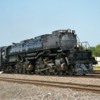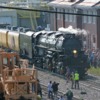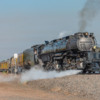Big Boy is on its 2021 tour. Departed Cheyenne on August 5. Went through my area today, again what a sight. There were a lot of people enjoying the views. This is the third time I have been able to see it since its restoration.
Replies sorted oldest to newest
It will be down here in Texas on Friday. My buddy and I plan on leaving early and catching it up in Oklahoma in the morning. We will then chase it back down into N. Texas. We already have a good spot located in our hometown to watch it climb the steepest southbound grade on the UP in Texas.
Jeff
Looking forward to seeing your photos, Jeff.
Got our hotel reservations for St. Louis on the 28th and 29th when it makes an overnight stop.
The Big Boy is a BEAST! Have the K-line steamer wish I could see this animal in action! keep the photos coming!
Very Nice Photos!
Keep America Free!
Closest us east coast guys will get is watching it on the VRF cameras. Caught it going through Kearney, Nebraska yesterday.
@RSJB18 posted:Closest us east coast guys will get is watching it on the VRF cameras. Caught it going through Kearney, Nebraska yesterday.
Hello RSJB18,
Could you be kind enough to post a link for the VRF cameras?
Thanks
@Allegheny posted:Hello RSJB18,
Could you be kind enough to post a link for the VRF cameras?
Thanks
This is the main page. From here you can get to the individual cameras
Thank you MartyE!
I plan to check it out on Friday in Pilot Point.
@Allegheny posted:Thank you MartyE!
I really enjoy the VRF channel. I can sit and click through some of these cameras for hours. When you select a camera from a PC go into the description as they might list additional cameras for that area facing opposite directions on an overview shot. Great YouTube channel.
By contrast, here are pictures of UP-4012 at Steamtown. Although it is just a stationary exhibit it still looks good. It was recently cosmetically restored. Nicely done. Too bad it doesn't run.
Attachments
Here is the video coming through Kearney, https://m.youtube.com/watch?v=CFDHp0951XM.
For the BB experts, is there a logic to what is in the consist?
Curious that in these videos the Big Boy is hauling only a very short consist of passenger cars, plus a load of hoppers behind those, and a bay window bringing up the rear. Great to see any caboose in action!
@breezinup posted:Curious that in these videos the Big Boy is hauling only a very short consist of passenger cars, plus a load of hoppers behind those,
Those hoppers are empties and provide braking assist due to such a short passenger consist. Once the remainder of the executive passengers are added in New Orleans (for the high roller's fund raising excursion) those empty hoppers will be dropped.
and a bay window bringing up the rear.
That "caboose" is part of the snow fighting equipment at Cheyenne, and is also used as a "Snow Bus" to ferry train crews, in really bad weather when the interstate & roads are closed to vehicular traffic.
Great to see any caboose in action!
I'll be down in N.O. to see it on the 21st. Really looking forward to it. It's going to be the first time seeing one in person for me. I will be seeing my dad as well. It's been a couple of years, so this will be a good thing to do together. I know it will be by the zoo but there is no info on the UP site about where exactly they are going to park it.
As for the short consist;
The 4014 is the star of the show and is out on a railfan tour.
It is not out there as a contest to see what it can pull.
Been watching the "Big Boy" running again from afar (Australia), and in all of the videos there is a constant stream of "steam" coming from a pipe at the end of the cab on the R/H side of the locomotive. What is that about as I don't remember seeing any steam coming from this area on its last trip?
Peter (Buco Australia)
@Buco posted:Been watching the "Big Boy" running again from afar (Australia), and in all of the videos there is a constant stream of "steam" coming from a pipe at the end of the cab on the R/H side of the locomotive. What is that about as I don't remember seeing any steam coming from this area on its last trip?
Peter (Buco Australia)
That is the continuous blowdown, as modified by the current manager. The same arrangement was done on 4-8-4 #844. Basically, the original Wilson Blowdown Separator system (sludge remover) has been repiped so the white mineral deposits are no longer deposited on the turret and cab roof, from the cylindrical "separator". It doesn't fully remove the sludge from the boiler, but at least the exterior remans nice and clean.
@GVDobler posted:As for the short consist;
The 4014 is the star of the show and is out on a railfan tour.
It is not out there as a contest to see what it can pull.
It's not about seeing how much it can pull (after all, anything it pulls on its tours is but a fraction of what it can), the point for me is that the engine looks odd with such an abbreviated consist, and one that has such an odd combination of cars, and which appears pretty rag-tag.
In setting up the piping arrangement for the Continuous Blow Down on the 4014, the UP steam crew has missed an opportunity to kill two birds with one stone, and make the whole thing a bit safer. Before I get into the details, allow me to explain what a "continuous blow down" is.
One of the most problematical issues that every steam locomotive crew has to deal with is the build-up of scale in the boiler. I won't go into all the ways that scale is harmful, I'll just tell you it is bad and you do not want it in your boiler. A continuous blow down is a small opening in the boiler at its lowest point. That's at the front of the firebox, down low, near the mud ring. A small pipe, about 1/2" in diameter, is piped from the boiler at that point. A steady stream of water is allowed to escape from this pipe as the locomotive operates. There is a valve on the pipe, operated from the cab, so the engineer can turn the blow down on or off. When turned on, the constant, low volume flow of water carries with it the tiny particles of scale that would otherwise accumulate somewhere inside the boiler.
NKP 765 has utilized a continuous blow down for years. However, we didn't just pipe it out to the side of the locomotive where the hot water could scald someone standing close to the track. We used the constant water flow from the blow down as a rail washer. Now I'm sure that some of you are asking yourself, "What's a rail washer?" The purpose of a rail washer is to wash sand from the rails after it has been used. Why do we want to do that? Because in hard pull situations with long trains or steep grades where we have to use sand, we don't want to have to drag the entire train through the sand! Sand causes additional drag on the train, so washing the sand off the rail after the drivers have used it is a smart thing to do.
On the 765, the pipe from the continuous blow down is split into two pipes. Those pipes spray the blow-down water on the rails right behind the #4 drivers, thus washing the sand off the rails. We actually have them positioned at a slight angle pointing into the gauge of the rail, so the spray is pointed slightly inward.
The advantages?
- The Continuous Blow Down runs 99% of the time the 765 is running.
- The Rail Washers are on 99% of the time the 765 is running.
- Because the water sprays inward towards the gauge of the rails, it poses no scalding danger to anyone.
My family and I chased it around today, really allot of fun!
Lots of great pacing opportunities as it approached KC coming out of Bonner Springs KS.
1st video is it on the KC fly over
2nd video is it backing in to KC union station after dropping off the hoppers.
Attachments
@Rich Melvin posted:In setting up the piping arrangement for the Continuous Blow Down on the 4014, the UP steam crew has missed an opportunity to kill two birds with one stone, and make the whole thing a bit safer. Before I get into the details, allow me to explain what a "continuous blow down" is.
One of the most problematical issues that every steam locomotive crew has to deal with is the build-up of scale in the boiler. I won't go into all the ways that scale is harmful, I'll just tell you it is bad and you do not want it in your boiler. A continuous blow down is a small opening in the boiler at its lowest point. That's at the front of the firebox, down low, near the mud ring. A small pipe, about 1/2" in diameter, is piped from the boiler at that point. A steady stream of water is allowed to escape from this pipe as the locomotive operates. There is a valve on the pipe, operated from the cab, so the engineer can turn the blow down on or off. When turned on, the constant, low volume flow of water carries with it the tiny particles of scale that would otherwise accumulate somewhere inside the boiler.
NKP 765 has utilized a continuous blow down for years. However, we didn't just pipe it out to the side of the locomotive where the hot water could scald someone standing close to the track. We used the constant water flow from the blow down as a rail washer. Now I'm sure that some of you are asking yourself, "What's a rail washer?" The purpose of a rail washer is to wash sand from the rails after it has been used. Why do we want to do that? Because in hard pull situations with long trains or steep grades where we have to use sand, we don't want to have to drag the entire train through the sand! Sand causes additional drag on the train, so washing the sand off the rail after the drivers have used it is a smart thing to do.
On the 765, the pipe from the continuous blow down is split into two pipes. Those pipes spray the blow-down water on the rails right behind the #4 drivers, thus washing the sand off the rails. We actually have them positioned at a slight angle pointing into the gauge of the rail, so the spray is pointed slightly inward.
The advantages?
- The Continuous Blow Down runs 99% of the time the 765 is running.
- The Rail Washers are on 99% of the time the 765 is running.
- Because the water sprays inward towards the gauge of the rails, it poses no scalding danger to anyone.
As someone who has very hard water in my house, I can appreciate the cleverness behind this, it is kind of like on my hot water heater flushing it from the bottom tap to get rid of scale and other stuff that is in there. Rich, on the 765, how much does using that decrease the range of the engine? I assume for short runs it is a no brainer, just curious on a long haul is it 5%, 10%?
The amount of water used by a continuous blow down/rail washer is insignificant. Doesn't change the range at all. In the big picture, it is a tiny amount of water being expelled.
They were routinely used back in the days of steam.
Nice shots Ken!
Archer Hill, 8/5
Pine Bluffs, WYO 8/5
Julesburg, CO 8/6
Lodgepole, NE 8/6
Paxton, NE 8/6
Sidney joining the main departure for NoPlatte 8/6
Ogallala, NE 8/6
A short video by my 7 year old son at Archer Hill on the 5th.
Attachments
Thank you Hot Water and Rich for the info and insight. I found it extremely interesting and comes from guys that have actually done the deed!!!
Peter (Buco Australia)
Erik, your photos always remind of UP calendar shots. You certainly know what you’re doing behind the lens. Very nice!
Erik,
Nicely framed! An artist at work!
Chris
LVHR
Eric,
You've done an excellent job with these photos, the composition is on the money!
It is coming to Houston next week.
Daffy Duck's pronoun trouble: How can you call a Big Boy a she
Attachments
Lodgepole is my favorite. thanks Eric.
Nice shots, Eric. I especially like the one with all the black eyed susans (I think that's what they are). Anyway, there's several posters in there.
Your son has his Father's eye for composition ...


























